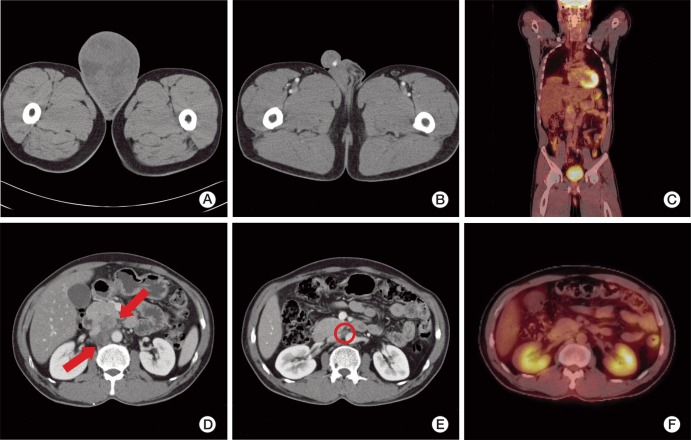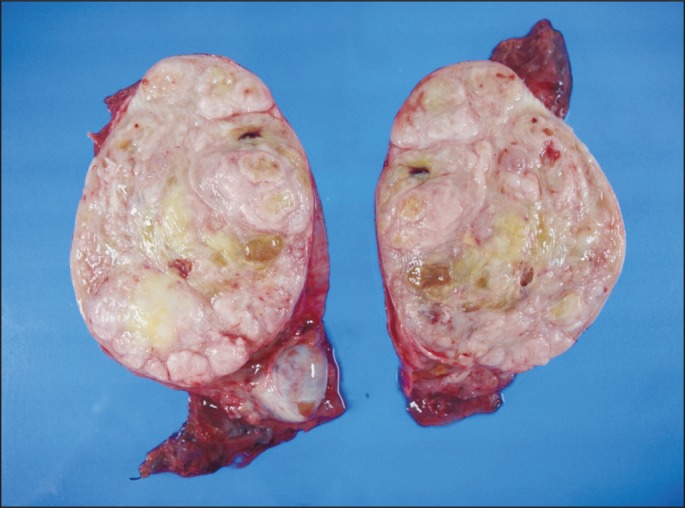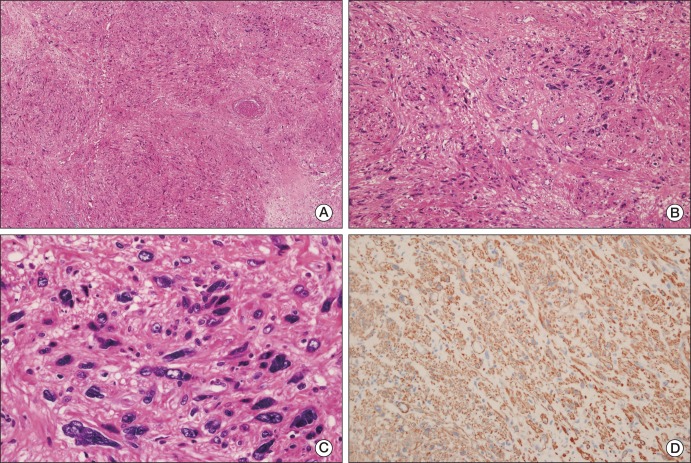Cancer Res Treat.
2012 Sep;44(3):210-214.
A Case of Paratesticular Leiomyosarcoma Successfully Treated with Orchiectomy and Chemotherapy
- Affiliations
-
- 1Department of Internal Medicine, Eulji University Hospital, Eulji University School of Medicine, Daejeon, Korea. lee982023@eulji.ac.kr
- 2Department of Urology, Eulji University Hospital, Eulji University School of Medicine, Daejeon, Korea.
- 3Department of Pathology, Eulji University Hospital, Eulji University School of Medicine, Daejeon, Korea.
Abstract
- A 50-year-old male patient presented with a right scrotal mass that had been growing rapidly for more than one year. A heterogeneous enhancing right scrotal mass (12x9 cm) with para-aortic and peri-caval lymphadenopathies was found on abdominal computed tomography (CT). Right orchiectomy was performed and the gross finding had shown intact testis with a well-defined, huge, whitish solid mass adjacent to the testis. According to pathology, the mass was characterized as a leiomyosarcoma, grade 3 (by National Cancer Instituted [NCI] system). Therefore, the diagnosis was stage III, grade 3 paratesticular leiomyosarcoma. The patient underwent additional systemic chemotherapy using ifosfamide and adriamycin. After nine cycles of chemotherapy, positron emission tomography-CT was performed and no FDP uptake was observed. The patient has been followed up for 12 months after systemic chemotherapy, and he has maintained a complete response. We report here on a rare case of paratesticular leiomyosarcoma treated successfully with orichiectomy and additional systemic chemotherapy.
Keyword
MeSH Terms
Figure
Reference
-
1. Lopes RI, Leite KR, Lopes RN. Paratesticular leiomyosarcoma treated by enucleation. Int Braz J Urol. 2006; 32:66–67. PMID: 16519831.
Article2. Khoubehi B, Mishra V, Ali M, Motiwala H, Karim O. Adult paratesticular tumours. BJU Int. 2002; 90:707–715. PMID: 12410753.
Article3. Dangle P, Basavaraj DR, Bhattarai S, Paul AB, Biyani CS. Leiomyosarcoma of the spermatic cord: case report and literature review. Can Urol Assoc J. 2007; 1:55–58. PMID: 18542764.
Article4. Hashimoto H, Daimaru Y, Tsuneyoshi M, Enjoji M. Leiomyosarcoma of the external soft tissues: a clinicopathologic, immunohistochemical, and electron microscopic study. Cancer. 1986; 57:2077–2088. PMID: 3513942.
Article5. Fisher C, Goldblum JR, Epstein JI, Montgomery E. Leiomyosarcoma of the paratesticular region: a clinicopathologic study. Am J Surg Pathol. 2001; 25:1143–1149. PMID: 11688573.6. Dalton DP, Rushovich AM, Victor TA, Larson R. Leiomyosarcoma of the scrotum in a man who had received scrotal irradiation as a child. J Urol. 1988; 139:136–138. PMID: 3275795.
Article7. Fagundes MA, Zietman AL, Althausen AF, Coen JJ, Shipley WU. The management of spermatic cord sarcoma. Cancer. 1996; 77:1873–1876. PMID: 8646687.
Article8. Adjuvant chemotherapy for localised resectable soft-tissue sarcoma of adults: meta-analysis of individual data. Sarcoma Meta-analysis Collaboration. Lancet. 1997; 350:1647–1654. PMID: 9400508.9. Coindre JM, Terrier P, Bui NB, Bonichon F, Collin F, Le Doussal V, et al. Prognostic factors in adult patients with locally controlled soft tissue sarcoma: a study of 546 patients from the French Federation of Cancer Centers Sarcoma Group. J Clin Oncol. 1996; 14:869–877. PMID: 8622035.
Article10. Chung HC, Lee HS, Kim TI, Eom MS, Song JM. Local recurrence of spermatic cord leiomyosarcoma. Korean J Urol. 2009; 50:92–95.
Article11. Kim BK, Chang HS, Park CH, Kim CI. Paratesticular leiomyosarcoma. Korean J Urol. 2005; 46:426–429.12. Yoon CY, Kwon SD, Cho JH, Kim CW. A case of leiomyosarcoma of the scrotum. Korean J Urol. 1996; 37:1421–1423.13. Ahn JS, Kim HJ, Kim YG, Park YK. A case of leiomyosarcoma of spermatic cord. Korean J Urol. 1992; 33:904–906.14. Jo EJ, Kang SJ, Han CS, Shin SJ, Choi SH. A case of leiomyosarcoma of the spermatic cord. Korean J Urol. 1989; 30:274–276.




